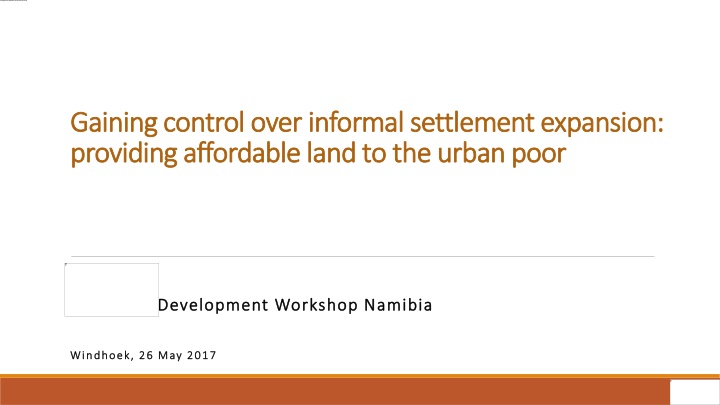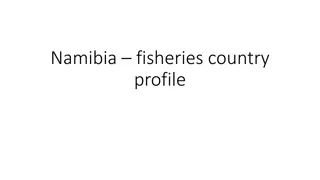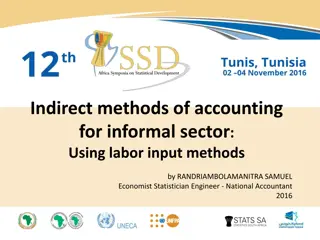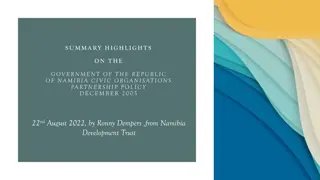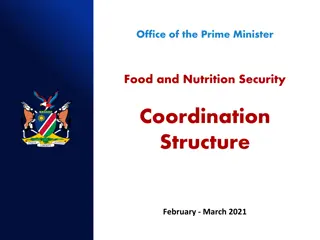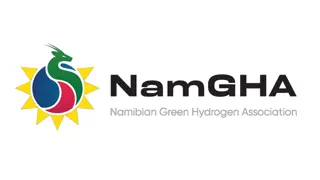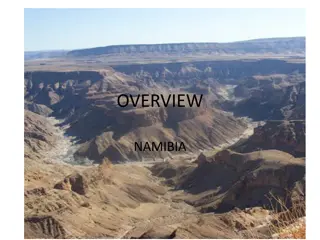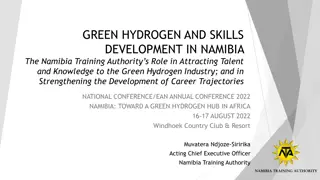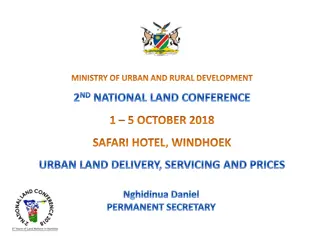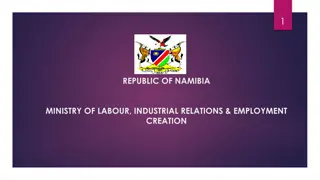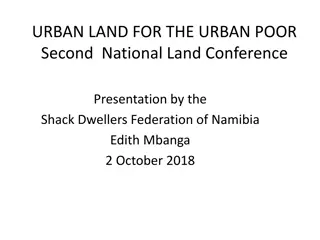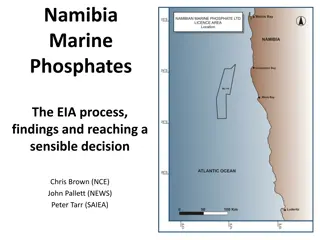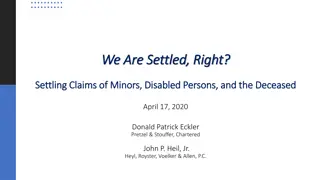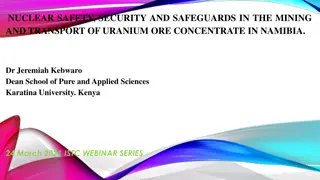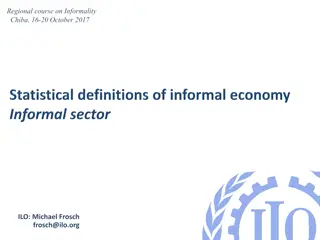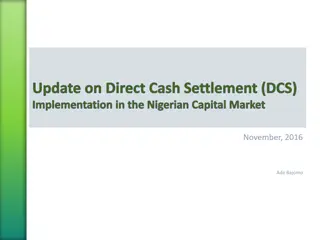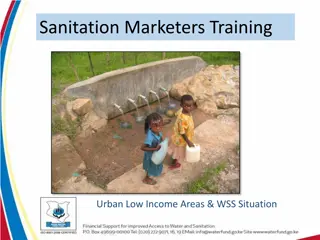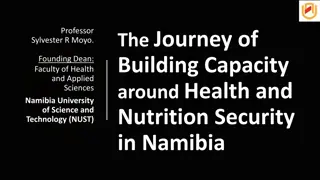Addressing Urban Informal Settlement Expansion in Namibia
Development Workshop Namibia focuses on providing affordable land and sustainable urban development to tackle the rapid growth of informal settlements in Namibia. With a network of organizations worldwide, they assess challenges in urban planning, document housing programs, and promote corporate sector involvement in housing provision. The urbanization trend signals a societal shift towards urban living in Namibia.
Download Presentation

Please find below an Image/Link to download the presentation.
The content on the website is provided AS IS for your information and personal use only. It may not be sold, licensed, or shared on other websites without obtaining consent from the author.If you encounter any issues during the download, it is possible that the publisher has removed the file from their server.
You are allowed to download the files provided on this website for personal or commercial use, subject to the condition that they are used lawfully. All files are the property of their respective owners.
The content on the website is provided AS IS for your information and personal use only. It may not be sold, licensed, or shared on other websites without obtaining consent from the author.
E N D
Presentation Transcript
Gaining control over informal settlement expansion: Gaining control over informal settlement expansion: providing affordable land to the urban poor providing affordable land to the urban poor Development Workshop Namibia Development Workshop Namibia Windhoek, 26 May 2017 Windhoek, 26 May 2017
An Introduction to Development Workshop Development Workshop (DW): NGO, founded in the 1970s by three Canadian architect students In Angola since 1981 upon invitation of Angolan Government To date second biggest NGO in Angola; specialized on urban development & planning, with focus on informal settlements; more than 150 employees at peak times; Supported several SWAPO projects in the early 1980s (Luanda & Kwanza Sul). Selected key interventions in Angola: Establishment of micro credit institution with currently more than 50,000 clients Financially sustainable social housing program Delivery of low cost urban land in several major towns National urban land management training program for local authorities accredited by Ministry of Territorial Administration (since 2007); Informal settlement servicing program (water & sanitation, running for more than 2 decades) Research and publications to inform policy and national programs
An introduction to Development Workshop Development Workshop Namibia (DWN) opened office in 2016 and part of the world wide network of DW organizations Focus on: urban planning & delivery of low cost urban land; sustainable urban development; research & publications Current main projects: Assessment of informal settlement growth and associated urban planning challenges (Outapi, Oshakati, Gobabis, Otjiwarongo, Windhoek); Basis for development of suggested low cost urban land delivery program. Documentation of B2Gold Assisted Home Ownership Program. Aim: promoting wider Namibian corporate sector involvement for the provision of housing for their employees as stated in Harambee Production of monthly publication, summarizing newspaper articles with relevance to urban development in Namibia (Media Monitoring on Urban Development in Namibia)
Rapid growth of informal settlements in Namibia Urban growth in Namibia following a regional trend of urbanization 2001-2011: rural population decreased by 20 000 / urban population increased by 300 000 Strong indicator that Namibia is transforming towards a society where most people live in urban areas
Rapid growth of informal settlements in Namibia Both formal and informal housing are increasing rapidly Main driver of urban growth: informal settlement Informal housing though at much faster rate From 2001-2011: formal housing increased 54% Informal housing increased 162% 2017 approx. 120 000 informal houses (with more than of Namibia s population) 10 000 - 15 000 new informal houses being erected each year Clearly visible by physical expansion of informal settlements
Rapid growth of informal settlements in Namibia - Windhoek Windhoek Roof top count of shacks in 2012 and 2016 (based on high resolution satellite image) Red: informal houses in 2012 Yellow: informal houses in 2016 Approx. 15 000 new shack- like structures within 4 years >3 500 shacks per year
Rapid growth of informal settlements in Namibia - Gobabis Gobabis Blue: shacks in 2012 Red: shacks in 2016 >1500 new shack-like structures within 4 years >350 shacks per year
Informal settlements entrenching socio-economic inequality Most informal settlements are not planned or physically structured: therefore, they cannot be legally proclaimed as townships; Not being legal townships, residents are not allowed to built with permanent structures and are obliged to live in corrugated iron shacks under deplorable living conditions; This puts an effective development ceiling on informal settlement households, affecting a large part of Namibia s population: Residents cannot built up savings and capital through investment in property pass it on to next generation; Lack of services puts great strains on economic productive household members (e.g.: 2011: 24% of urban households without access to toilet facilities) Additional negative consequences: Creation of huge pockets of poverty and discontent with considerable risks future social and political stability; Constrain on construction industry in major urban centres: large percentage of informal settlement residents would have financial means to invest into brick & mortar houses, even if incrementally over longer periods of time. Loss of tax income by government and local authorities due to informal use of land and housing Severe urban crisis: rapidly growing informal settlements effectively cement social and economic inequality, put social and political stability at risk and limit economic potential of important industrial sectors. They are becoming a huge legacy for future generations and governments.
Key issues: Informal settlement upgrading & prevention Letting informal settlements grow unplanned for future upgrading is not a good option 1. Currently, most informal settlements in Namibia grow without any urban planning intervention 2. The result: no physical structure (no planned road layout, lack of reserved space for services e.g. schools, health posts) 3. Upgrading such settlements becomes very difficult as population densities increase. It involves physical restructuring, demolition of shacks that are in way of new roads and involving compensation payments. 4. It is also a very time consuming process: An upgrading project for a settlement of 1000 households can easily last 3-4 years, as it involves a lot of negotiation and often also opposition from residents. 5. The benefits of an upgrading project are often overtaken by rapid informal settlement growth at the periphery. For example, while an upgrading of 1000 households is underway, some 2000 new informal houses may be erected at the town s periphery during the same period of time, limiting the town wide impact of the upgrading project. 6. Without preventing the growth of informal settlement expansion, upgrading risks to become a never-ending and expensive exercise, trying to, but not managing, to catch up with rapid informal settlement expansion.
Key issues: Informal settlement upgrading & prevention It can therefore be considered an absolute priority to apply a preventive approach to avoid the creation of new unstructured informal settlements If expanding informal settlements are minimally planned and structured, providing surveyed erven for the residents: 1. They can subsequently be proclaimed legal townships 2. Residents can then obtain tenure security and are enabled mobilize own funds to invest into their property and create wealth across generations 3. And with an existing road layout, servicing becomes much easier and cost efficient than in unplanned settlements Therefore: To control and guide informal settlement growth, affordable erven must be made available to the low income segment of the population, ensuring that people settle orderly from the beginning Such structured newly planned settlements may be informal at the beginning as statutory township proclamation takes time. However, as they are planned according to Namibian town planning principles, they can subsequently undergo township proclamation. The number of erven made available in each town must respond to local demand (e.g. as indicated by annual growth of shacks)
Affordability of provided erven Fully serviced average residential erf costs N$ 70 000 100 000 (not affordable for low income residents) Land surveying and planning costs: 3-5% of overall amount; remaining costs are services Therefore: properly planned and surveyed erven can be provided at N$3000-5000 Minimal (but upgradable) services can be provided to guarantee sanitary standards, such as communal water points, support to self construction of pit latrines and levelling of roads. Using such approach keeps costs/erf at N$ 5 000-10 000 This is affordable for a great majority of the low income segment of the population This approach is actually practiced by some local authorities
Provision of low cost erven by local authorities Otjiwarongo: Achieved almost complete control over informal settlement growth by providing non- serviced erven to low income residents; township proclamation and service upgrading currently underway Oshakati, Outapi and Gobabis: applied similar approaches, at smaller scale Challenges faced by local authorities: Lack of project management capacity Limited technical capacities of in-house staff Lack of funds for up-front payments for land surveyors and town planners (result: no topographical survey/errors in erf demarcation) Quality of new layouts in terms of urban design
Provision of low cost erven by local authorities Summary of this approach observed in some of the sample towns of the research: A planning consultant provides a simple layout plan for a new area to be developed (sometimes on a pro- bono basis); LA use in-house capacities to demarcate the plots, using optical surveying equipment such as theodolite and measuring tape; The plots are transferred to people residing in existing informal settlements; Upon transfer of the plot, the new residents receive a tenure document issued by the local authority. Such a document is not regulated by any legislation, but serves as locally accepted tenure security. The document usually also states different conditions, such as the acceptance of the plot owner to reside on a plot without (or with minimal) services and the prohibition to erect any permanent structures until the new layout is formally legalized following statutory processes. The document further specifies any fees to be paid by the owners, such as monthly rental fees to the local authority; When or if funds become available, the local authority then prepares for statutory submission of township establishment; Once the township has been established, the plot owners can buy the plot (in Outapi for example at N$15/m2, this being N$4500 for a standard sized 300m2 plot); Local authority may also facilitate acquisition of freehold title (in Outapi the local authorities provide this service for a fee of N$ 2700); The settlement is then upgraded incrementally as funds become available through different channels. (It has been observed that upgrading can already occur while township establishment procedure is still in progress).
Program to deliver low cost erven DWN is in the process of initiating a program to provide support to local authorities to develop new or up-scale existing initiatives for the provision of low cost urban land in properly planned and surveyed settlements as an alternative to unstructured informal settlement growth: Acquisition of funding through international donors, corporate sector, banks Project management support & technical training to local authorities Establish benchmark of number of low cost land to be provided annually to contain uncontrolled informal settlement growth Agreement exists between DWN and Oshakati Town Council for a pilot project Can be done on a cost-recovery basis: Initial fund (grant or commercial loan) of for example N$ 1 million allows the provision of 150- 200 erven Sale proceeds of these erven go to a revolving fund to allow roll-over of the project to a new area (no more additional external funding needed) Such revolving funds could incrementally be created in towns across Namibia
Some key issues: Affordable urban land is the key issue, not housing as such. By providing legal land to the poor, household level development potential can be liberated (creation of enabling environment). Planned physical structure is a key element for making informal settlements upgradable. It is a key aspect that conditions the development options of a settlement and its residents. Mechanisms must be created to get urban expansion under control. Only if there is control, it can be directed meaningfully according to principles of sustainable urban development and urban design (e.g. mixed use, densification, in-fill). Any response to the housing/land issue should be done based on real local demand, to ensure that available resources are used to holistically approach the issue. Effective delivery of land can be done within the current legal and administrative context as the presented examples show. Changes in policy and legislation are desirable, but not a prerequisite for the more efficient delivery of low cost land However, the 300m2 policy should be abolished. It condemns large parts of upgraded informal settlement residents to continue residing in unproclaimed areas
Some questions. What are the potential pitfalls of a low cost land delivery program? What kind of participatory mechanisms exist and could be further explored to make urban planning and development more social inclusive and economically effective? Developing settlements for the urban poor by providing affordable land is a real opportunity to creating real neighbourhoods, not low income dormitories with ever increasing commuting distances. Are there examples in Namibia how this as been accomplished for low income areas? As long as the 300m2 policy exists: what are the best ways around it? What would be the advantages/disadvantages of applying the Flexible Land Tenure System for a low cost land delivery program?
